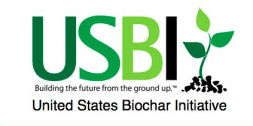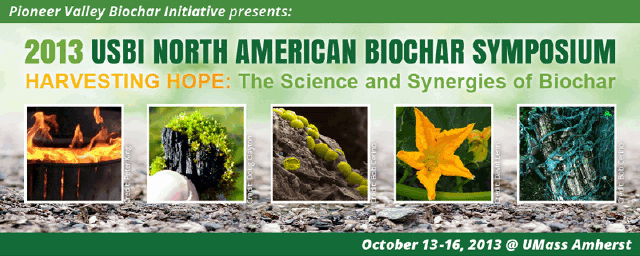Benefits & Uses of Biochar
Habitat Restoration
Katherine Ballantine presentation
B&U Session 2 - Thomas S.pdf (1519 kB)
Sean Thomas presentation
B&U Session 2 - McCormick.pdf (12084 kB)
Thomas McCormick presentation
Location
CC 101
Start Date
14-10-2013 1:30 PM
End Date
14-10-2013 2:50 PM
Session Description
Wetlands – K. Ballantine, Mt. Holyoke
The use of biochar as a soil amendment is a novel and potentially powerful innovation in wetland restoration methodology. Wetland restoration is commonly used as a strategy both to address historic wetland losses and to mitigate new wetland impacts. Research examining the development of restored wetlands shows, however, that such wetlands often take many decades, if ever, to achieve the functions for which they are restored. Biochar’s high affinity for nutrients and its high persistence make it a promising amendment for restored wetlands because: 1) wetlands are favored as long-term carbon (C) stores and biochar could support this function, currently at risk due to global climate change. 2) Incorporation of biochar into restoration methodology could increase the success of wetland projects with water quality goals, because biochar could increase removal of excess nitrogen (N) and phosphorus (P) in runoff. 3) Reductions of greenhouse gases by biochar amendments in restored wetlands could significantly decrease the global warming potential of wetlands. 4) Biochar may increase plant growth and vigor in restored wetlands, thus jumpstarting habitat creation for target species and soil development.
The objective of our current research is to compare the influence of wetland soil amendments on N and P removal (water quality functions); emissions of carbon dioxide, nitrous oxide, and methane (climate change functions); and plant growth and diversity (vegetative functions) of nine depressional freshwater wetlands restored in August, 2007 and 2009 in central New York, USA. The soil amendments fall along a gradient of C lability, with biochar (slow pyrolysis corn stover and fast pyrolysis wood char) and biochar mixes (biochar + straw) as the least labile amendments. We are using a controlled greenhouse experiment and complimentary field-scale manipulation to analyze the soil physical variables (e.g., soil texture and bulk density), chemical variables (e.g., N and P uptake), and biological variables (e.g., microbial processes) that influence ecosystem functions. We hypothesize that variations in water quality functions, climate change functions, and vegetative functions are driven by differences in soil quality and microbial processes that result from unique properties, particularly C lability, associated with the amendment treatments. Preliminary field experiment results will be presented.
Forest Eco-systems – S. Thomas, University of Toronto
To date, biochar research has focused almost entirely on responses of agricultural crops. Biochar may also be a viable soil amendment in managed forest ecosystems to reduce soil acidity, enhance nutrient availability, and to emulate natural fire disturbances. We present an overview of a large project examining the potential for biochar in Canadian forestry, including climate mitigation, assessment of long-term carbon dynamics, and life-cycle analysis components; we also give detailed results on the responses of tree seedlings to biochar applications. We examined growth and gas-exchange responses of eight temperate deciduous tree species to soil surface applications of biochar and phosphorus over one growing season in a factorial glasshouse experiment. The soil used was acidic, from a region in which prior studies indicate phosphorus (P) deficiency. All tree species examined showed strongly positive growth responses to P additions, consistent with P limitation. In contrast, growth responses to biochar were mixed, with positive, neutral, and negative responses observed. Only one species (Betula papyrifera) showed a significant P x biochar interaction consistent with a nutrient “priming” mechanism. Large but species-specific effects of P and biochar additions were also observed for physiological variables, including photosynthetic capacity, leaf dark respiration, leaf mass per area, and leaf reflectance indicators of pigment concentrations. We conclude that temperate tree species show highly variable early responses to biochar, including cases of negative effects that are not alleviated by “priming” biochar with limiting nutrients. Our results caution that biochar effects are not always positive, and suggest that biochar additions on a large scale will require close assessment of species-specific responses, and may result in substantial impacts on forest species composition and diversity. Negative effects, where observed, are likely driven by organic chemicals sorbed during biochar production, and current work is assessing means of post-processing biochar to reduce or eliminate this problem.
Salt Water Marshes – T. McCormick, McCormick Environmental
Biochar and biochar compost mixes were used in experimental trials intended to accelerate the restoration of a disturbed salt marsh to fully functioning wetland habitat. We used a Randomized Complete Block experimental design to test several biochar treatments at two salt marsh sites. Both sites had been restored with fill not characteristic of a salt marsh. Treatments consisted of 1 meter2 plots within each of four blocks (replicates), two blocks at each site. Two manufacturers supplied biochar as follows: 20% biochar + 80% compost, 30% biochar + 70% compost, and 100% biochar. Biochar mixes were rototilled into the soil at rates from 4.8 to 40 kg of biochar per square meter. Half of the treatments received seed from Parish’s Glasswort Anthrocnemum (Salicornia) terminalis the other half were left unseeded to determine natural recruitment. To track biochar retention and migration through the soil profile soil samples were taken to determine the amount of carbon in the soil prior to treatment, just after treatment, and 6 months after treatment.
The use of biochar to enhance the growth of salt marsh flora may prove an innovative cost-effective solution for habitat restoration and remediation. Biochar use may also improve environmental performance and reduce restoration costs. Results of planting of salt marsh plants with biochar are also discussed.
Habitat Restoration
CC 101
Wetlands – K. Ballantine, Mt. Holyoke
The use of biochar as a soil amendment is a novel and potentially powerful innovation in wetland restoration methodology. Wetland restoration is commonly used as a strategy both to address historic wetland losses and to mitigate new wetland impacts. Research examining the development of restored wetlands shows, however, that such wetlands often take many decades, if ever, to achieve the functions for which they are restored. Biochar’s high affinity for nutrients and its high persistence make it a promising amendment for restored wetlands because: 1) wetlands are favored as long-term carbon (C) stores and biochar could support this function, currently at risk due to global climate change. 2) Incorporation of biochar into restoration methodology could increase the success of wetland projects with water quality goals, because biochar could increase removal of excess nitrogen (N) and phosphorus (P) in runoff. 3) Reductions of greenhouse gases by biochar amendments in restored wetlands could significantly decrease the global warming potential of wetlands. 4) Biochar may increase plant growth and vigor in restored wetlands, thus jumpstarting habitat creation for target species and soil development.
The objective of our current research is to compare the influence of wetland soil amendments on N and P removal (water quality functions); emissions of carbon dioxide, nitrous oxide, and methane (climate change functions); and plant growth and diversity (vegetative functions) of nine depressional freshwater wetlands restored in August, 2007 and 2009 in central New York, USA. The soil amendments fall along a gradient of C lability, with biochar (slow pyrolysis corn stover and fast pyrolysis wood char) and biochar mixes (biochar + straw) as the least labile amendments. We are using a controlled greenhouse experiment and complimentary field-scale manipulation to analyze the soil physical variables (e.g., soil texture and bulk density), chemical variables (e.g., N and P uptake), and biological variables (e.g., microbial processes) that influence ecosystem functions. We hypothesize that variations in water quality functions, climate change functions, and vegetative functions are driven by differences in soil quality and microbial processes that result from unique properties, particularly C lability, associated with the amendment treatments. Preliminary field experiment results will be presented.
Forest Eco-systems – S. Thomas, University of Toronto
To date, biochar research has focused almost entirely on responses of agricultural crops. Biochar may also be a viable soil amendment in managed forest ecosystems to reduce soil acidity, enhance nutrient availability, and to emulate natural fire disturbances. We present an overview of a large project examining the potential for biochar in Canadian forestry, including climate mitigation, assessment of long-term carbon dynamics, and life-cycle analysis components; we also give detailed results on the responses of tree seedlings to biochar applications. We examined growth and gas-exchange responses of eight temperate deciduous tree species to soil surface applications of biochar and phosphorus over one growing season in a factorial glasshouse experiment. The soil used was acidic, from a region in which prior studies indicate phosphorus (P) deficiency. All tree species examined showed strongly positive growth responses to P additions, consistent with P limitation. In contrast, growth responses to biochar were mixed, with positive, neutral, and negative responses observed. Only one species (Betula papyrifera) showed a significant P x biochar interaction consistent with a nutrient “priming” mechanism. Large but species-specific effects of P and biochar additions were also observed for physiological variables, including photosynthetic capacity, leaf dark respiration, leaf mass per area, and leaf reflectance indicators of pigment concentrations. We conclude that temperate tree species show highly variable early responses to biochar, including cases of negative effects that are not alleviated by “priming” biochar with limiting nutrients. Our results caution that biochar effects are not always positive, and suggest that biochar additions on a large scale will require close assessment of species-specific responses, and may result in substantial impacts on forest species composition and diversity. Negative effects, where observed, are likely driven by organic chemicals sorbed during biochar production, and current work is assessing means of post-processing biochar to reduce or eliminate this problem.
Salt Water Marshes – T. McCormick, McCormick Environmental
Biochar and biochar compost mixes were used in experimental trials intended to accelerate the restoration of a disturbed salt marsh to fully functioning wetland habitat. We used a Randomized Complete Block experimental design to test several biochar treatments at two salt marsh sites. Both sites had been restored with fill not characteristic of a salt marsh. Treatments consisted of 1 meter2 plots within each of four blocks (replicates), two blocks at each site. Two manufacturers supplied biochar as follows: 20% biochar + 80% compost, 30% biochar + 70% compost, and 100% biochar. Biochar mixes were rototilled into the soil at rates from 4.8 to 40 kg of biochar per square meter. Half of the treatments received seed from Parish’s Glasswort Anthrocnemum (Salicornia) terminalis the other half were left unseeded to determine natural recruitment. To track biochar retention and migration through the soil profile soil samples were taken to determine the amount of carbon in the soil prior to treatment, just after treatment, and 6 months after treatment.
The use of biochar to enhance the growth of salt marsh flora may prove an innovative cost-effective solution for habitat restoration and remediation. Biochar use may also improve environmental performance and reduce restoration costs. Results of planting of salt marsh plants with biochar are also discussed.



Bio and Photo
Dr. Ballantine’s research interests center on the long-term development and ecosystem functions of restored and created ecosystems. She is currently investigating soil and vegetative development of restored wetland ecosystems, the mechanisms that underlie water quality and climate change functions, and the influence of environmental variability on these functions. She is an Assistant Professor of Environmental Science at Mount Holyoke College.
Sean Thomas (PhD Harvard 1993) is the lab Principal Investigator and has been preoccupied with comparative biology of tree and forest responses to the intentional and accidental impacts of humans for some 25 years. Sean has been at the University of Toronto since 1999 and is currently appointed as the Canada Research Chair (Tier 1) in Forests and Environmental Change.
Thomas McCormick